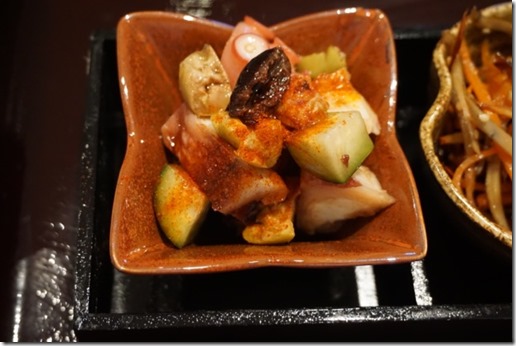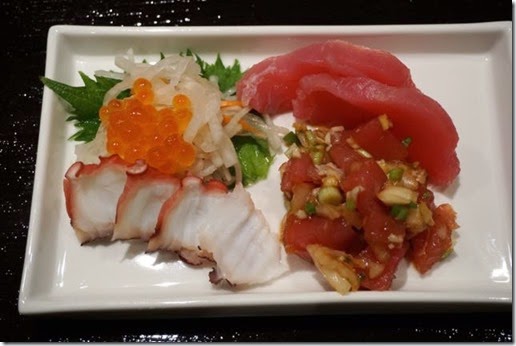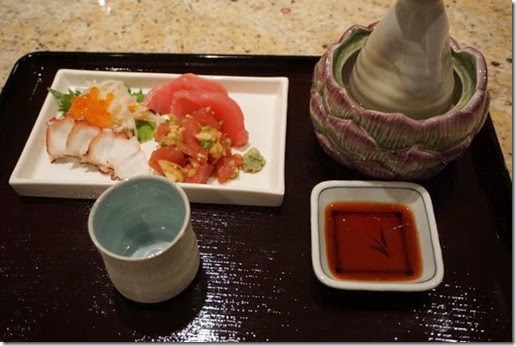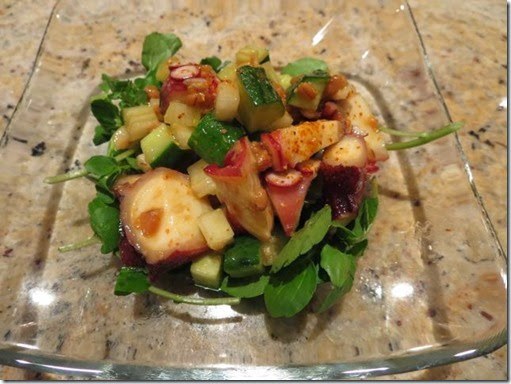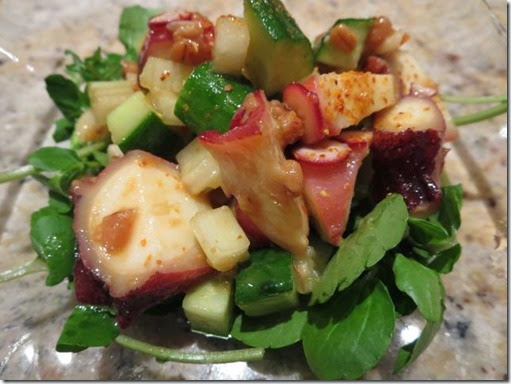Growing up in Sapporo 札幌, Hokkaido, takoyaki たこ焼き was not an item I encountered often. So-called "
Konamon" こなもん food cultures are an Oosaka 大阪 (Kansai 関西) tradition which may include takoyaki, okonomiyaki お好み焼き as well as noodles (especially udon). "Kona" 粉 means flour and anything made from flour may qualify as "konamon" but the exact definition escapes me.
One of the reasons I made takoyaki was because this gave me another post but also because of my sister-in-law gave me an
electric ebelskiver cooker as a Christmas present. After several of the cookers were delivered by Federal Express Ground to random locations other than our house it finally arrived last week—only 2 months late for the Christmas holiday. When I saw the cooker all I could think was Takoyaki. The size of the cooking wells and resulting product were larger than traditional Takoyaki but my wife said, “just call it American style takoyaki.
I made a takoyaki sauce and garnished with bonito flake powder and "aonori" 青海苔. For the first try, this was good with a crunchy outside and molten soft inside centered with a piece of boiled octopus leg.
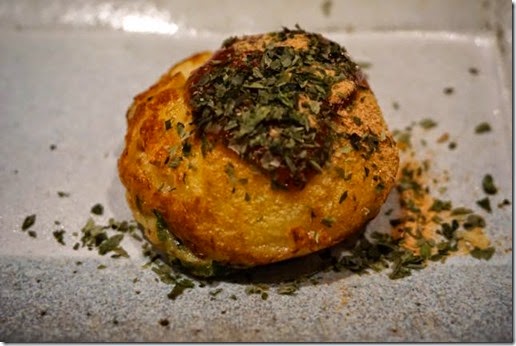
Since this is not a type of food I grew up with, I looked for an authentic recipe for takoyaki. After looking through various recipes, I settled for
the recipe which was written in Osaka dialect (a true sign of its authenticity).
Ingredients:
Takoyaki sauce: A mixture of
Lee and Perrin worcestershire sauce, ketchup, and honey. The ratio of the Worcestershire sauce and ketchup is about 1:2 and honey to your liking of sweetness. The authentic sauce is supposedly rather sweet. Among the pre-made commercial sauce,
Otafuku brand takoyaki sauce おたふくたこ焼きソース is most popular. (left, upper).
Boiled octopus leg: I just cut into 1/2 inch or 1cm chunks (I made 12) (right lower).
Scallion: Finely chopped about 4 stalks (left lower) (1 tsp per ball).
Tenkasu*: See picture and write up below. (1/2 to 1 tsp per ball).
In terms of the garnish, I prepared dried "aonori" (upper right) and dried bonito powder (middle right, I made bonito powder by grinding the bonito flakes in a Japanese mortar and pestol (suribachi すり鉢) but this is not necessary (use as is).
I did not use additional items such as red pickled ginger (紅生姜) or small dried shrimp (桜エビ). According to this recipe, adding shredded cabbage is totally not authentic. If used, it should be called "Okonomiyaki" ball rather than takoyaki.
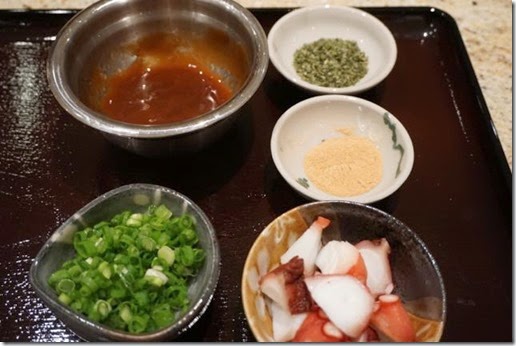
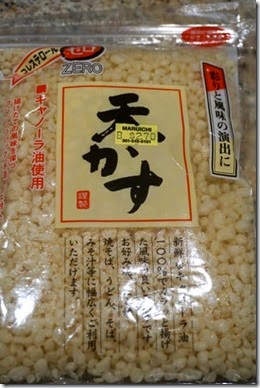
*
Tenkasu: One more ingredient I needed was "tenkasu"
天かす or "agedama" 揚げ玉 a by-product of making tempura. They are the small fried tempura bits of batter that come off the main tempura while it is being cooked. They are quickly removed from the oil before they burn. Besides being used in making takoyaki and okonomi-yaki, they can be used as a topping for noodles (such as in "
Tanuki" udon or soba), miso soup and other dishes.
Interestingly, in Hokkaido they are more commonly called "agedama" or "fried balls". This is a term I prefer to Tenkatsu which literally means "wastage or scum" of tempura and does not sound particularly appetizing to me. They used to be discarded or given away free at tempura or soba restaurants but more recently, packaged commercial products can be had (some even flavored by ground up dried shrimp). I could have made this myself but for takoyaki, I bought pre-made one, as seen on the left, at my Japanese grocery store.
The advert on the package boasts of supposed health aspects of this otherwise unhealthy product. The package indicated it was healthy because it was fried in Canola oil and 0% cholesterol (same in any other vegetable oil). Maybe this is better than if they were fried in tallow but the distinction seems slim to me. I see similar amusing claims on potato chip packages touting how healthy they are. In any case, surprisingly they were not oily and had no smell or taste of oxidized oil but, by the same token, they had no flavor whatsoever, only texture. We were not sure this added anything special to our takoyaki (I added about 1 tsp per ball).
Batter: The batter is most important. I like this recipe since it was proportional based on the numbers of eggs used. The important things seem to be; 1. Use a good quality cake flour, 2. Liquid and flour ratio is 1:4 to 1:4.5 (some recipes call for 1:5 ratio), 3. Use of powdered skim milk and baking powder (They are recent additions and improve the quality of takoyaki according to this author. He referred to these additions as "progress"). I really liked this approach so I translated his chart below.
Numbers of
takoyaki | Cake flour | Powdered
milk | Baking powder | Sugar | Salt | Soy sauce | Dashi
broth | Eggs |
| 20 (12*) | 70g | 1 tbs | 1/2 tsp | 1 tsp | 1/4 tsp | 1 tsp | 300cc | 1 |
| 40 | 140g | 2tbs | 1 tsp | 2 tsp | 1/2 tsp | 2 tsp | 600cc | 2 |
| 60 | 210g | 3tbs | 1.5 tsp | 3tsp | 3/4tsp | 3 tsp | 900cc | 3 |
*12 using my ebleskiver maker.
I made the smallest amount (i.e. using one egg). This amount should make 20 takoyaki but with my American style takoyaki/ebleskiver cooker, I could make only 12 since the diameter of the wells are 5.5cm as opposed to either 3.5 or 4.2 cm of authentic takoyaki grills. I think the size difference is not a problem, at least for us. I used about 10cc of 1% milk since I did not have powdered skim milk and reduced the dashi by that amount. The dashi was made with kelp and bonito flakes as usual. I did not sift the flour (which is recommended) but added the cold liquid into the dry ingredients gradually as I whisked. It made a rather thin batter. I let it refrigerate for several hours before using.
Assembly: This is where the fun starts. I preheated my ebleskiver maker on "High" setting for several minutes. Using vegetable oil and paper towel, I oiled the wells and the top surface (this has Teflon coating). I poured the batter (after mixing it again) to 90% of the well (se below)
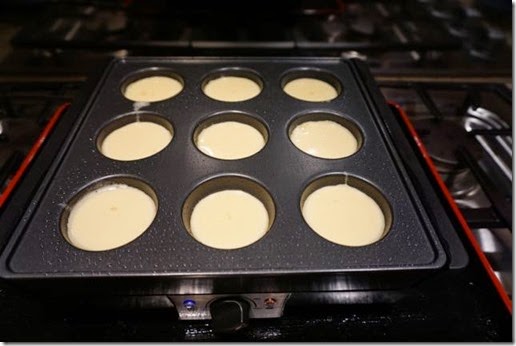
After few minutes the edges started bubbling and I added the octopus leg (below).
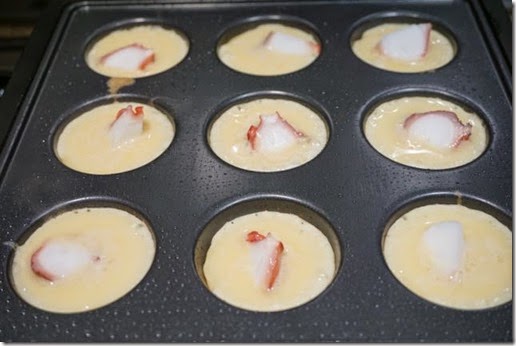
I then added the scallion (about 1 tsp) and the tenkatsu (1 tsp) and topped it off with more batter (see below).

Using the bamboo skewer and the special sticks came with the ebleskiver maker, I tested if the bottom was set and started turning them over (below).

I turned them over few more times to make all the surface equally brown (see below).

The center should be still molten (as I was told) so I declared these done.
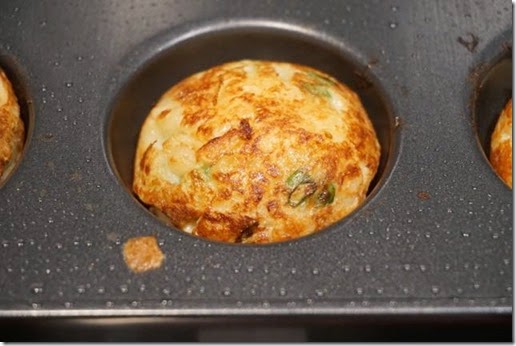
I brushed a small amount of my takoyaki sauce (mine is not as sweet as real Osaka style but I thought it was good. My wife said the sauce made the dish.) I then sprinkled on a pinch of the bonito powder and aonori powder (the first picture).
The center was very hot and molten. My wife thought that, instead of octopus leg, we could use shrimp (which I agree but then it will not be called takoyaki—maybe ebiyaki?). Another natural variation would be the addition of cheeses. Since I made "authentic" takoyaki, I may experiment with more variations (of course, I may consider making ebleskiver as well). We made total of 12 (9 in the first batch and three more). Between two of us, we finished all 12 in no time.

